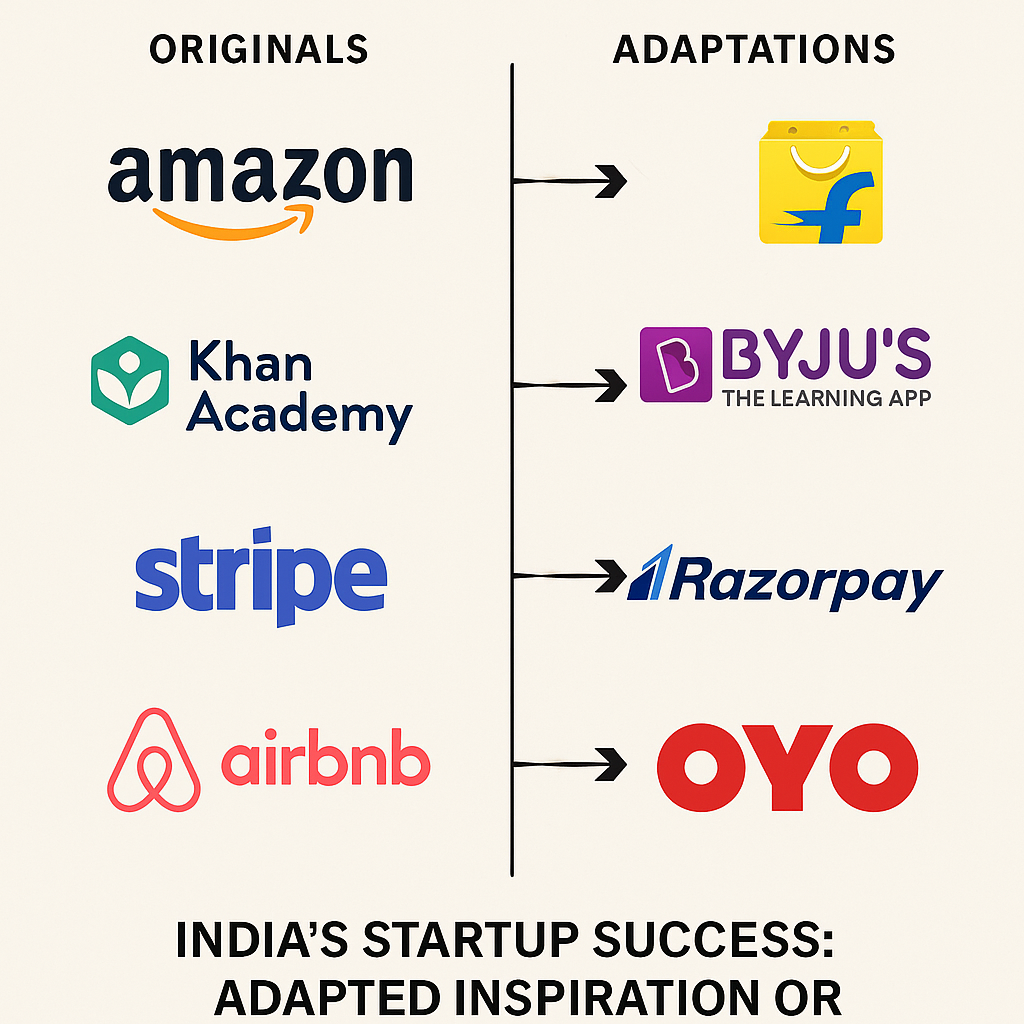Summary Highlights:
- Over 90% of successful Indian startups are modeled after global counterparts.
- Flipkart, Byju’s, Razorpay, and OYO follow the playbooks of Amazon, Khan Academy, Stripe, and Airbnb respectively.
- Indian adaptations often outperform originals in execution, market penetration, and localization.
- The ecosystem reflects a pragmatic approach: replicate proven ideas, refine for India, and scale aggressively.
India’s vibrant startup ecosystem, now the third-largest in the world, is often celebrated for its rapid growth and unicorn surge. However, a critical observation underlies this success: a significant majority of Indian startups are built on business models previously established in global markets.
This trend is less about imitation and more about contextual adaptation. Here’s a comparative breakdown of leading Indian startups and their global inspirations—revealing a pattern of successful replication with strategic localization.
Flipkart vs Amazon: The E-Commerce Blueprint
- Amazon (USA) launched in 1994 and pioneered the global online marketplace.
- Flipkart (India) was founded in 2007 by former Amazon employees Sachin and Binny Bansal.
Key Commonalities:
- Marketplace format with customer reviews, product listings, and third-party sellers.
- Advanced logistics and warehousing systems.
India-Specific Innovations by Flipkart:
- Cash-on-Delivery (CoD) payment option—critical for India’s low credit card penetration.
- Localized logistics networks and hyperlocal delivery.
- Festive sales events tailored to Indian shopping behavior.
Result:
Acquired by Walmart in 2018 for Rs 1,07,000 crore ($16 billion), Flipkart became a cornerstone of India’s e-commerce evolution.
ALSO READ: Zomato Shuts Down 15-Minute Delivery Services ‘Instant’ and ‘Everyday’ Amid Strategic Shift
Byju’s vs Khan Academy: Commercial EdTech vs Nonprofit Learning
- Khan Academy (USA) is a nonprofit offering free online education globally.
- Byju’s (India), launched in 2015, monetized digital learning with a paid subscription model.
Shared Features:
- Video-based learning modules.
- Curriculum-based content tailored to students’ levels.
Strategic Differentiation:
- Byju’s integrates visual storytelling, gamification, and celebrity marketing.
- Operates as a for-profit platform with aggressive customer acquisition strategies.
Result:
Once valued at Rs 1,87,000 crore ($22 billion), Byju’s scaled rapidly across India and international markets despite recent financial scrutiny.
Razorpay vs Stripe: Fintech Innovation, Localized
- Stripe (USA), launched in 2010, revolutionized online payments for developers and startups.
- Razorpay (India) emerged in 2014 with a similar API-first model.
Common Ground:
- Online payment infrastructure for businesses.
- Emphasis on seamless integration and user experience.
India-Focused Execution:
- UPI support, wallet integrations, and bank APIs.
- GST invoicing, compliance solutions, and regional payment options.
Current Status:
Razorpay is valued at Rs 55,000 crore ($6.6 billion) and is a market leader in Indian digital payments.
ALSO READ: Copying or Creating? How Indian Startups Are Shaping Innovation Their Own Way
OYO vs Airbnb: Hospitality Models Diverge
- Airbnb (USA) connects travelers with hosts, operating on a peer-to-peer model.
- OYO (India) launched in 2013 with an asset-heavy approach, leasing and standardizing hotel rooms.
Distinct Model:
- OYO manages and rebrands properties under its name, unlike Airbnb’s host-driven structure.
- Offers standardized services across budget hotels.
Advantage:
OYO’s control over operations allowed it to scale rapidly in price-sensitive and fragmented markets.
BookMyShow vs Fandango: Localizing Entertainment Ticketing
- Fandango (USA) specializes in online movie ticketing.
- BookMyShow (India) began in 2007, mirroring this concept for Indian users.
Enhanced for Indian Audiences:
- Expanded services to sports, concerts, and regional events.
- Built robust app infrastructure with local payment solutions and regional language support.
Outcome:
BookMyShow dominates India’s entertainment booking market with a valuation exceeding Rs 4,000 crore.
Zomato & Swiggy vs DoorDash: Delivery, Indian Style
- DoorDash (USA) focuses on food delivery with a logistics-first model.
- Zomato (2008) and Swiggy (2014) refined this approach for Indian cities.
Adaptations:
- Expanded into grocery and instant delivery services (e.g., Blinkit, Instamart).
- Deep regional reach, localized pricing, and offers tailored to Indian users.
Collective Valuation:
Together, Zomato and Swiggy are valued at over Rs 1,24,000 crore ($15 billion).
Analysis: Innovation vs Execution
While these examples suggest a heavy reliance on international ideas, the real differentiator lies in execution:
- Indian startups adapt products to infrastructure gaps, payment barriers, and cultural nuances.
- Scaling in India demands operational intensity and constant iteration.
Is copying a weakness?
Not necessarily. Many of India’s most celebrated startups succeeded not by being first, but by being faster, better, and more localized.
Conclusion: The Indian Way of Building
India’s startup ecosystem reflects a strategic playbook—learn globally, execute locally.
Rather than reinventing the wheel, Indian founders are redefining it for a diverse, high-growth, and mobile-first economy. The approach may be derivative, but the impact is undeniably transformative.



